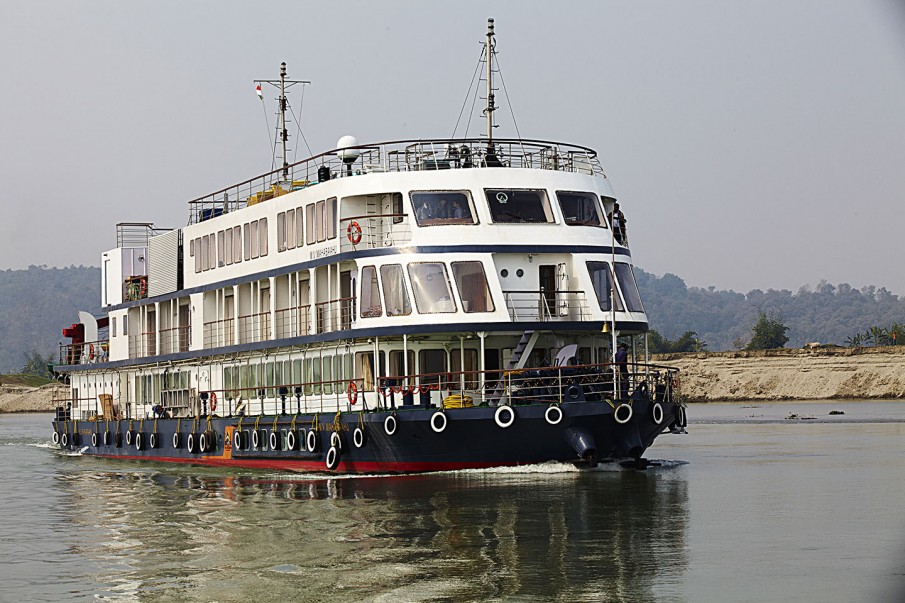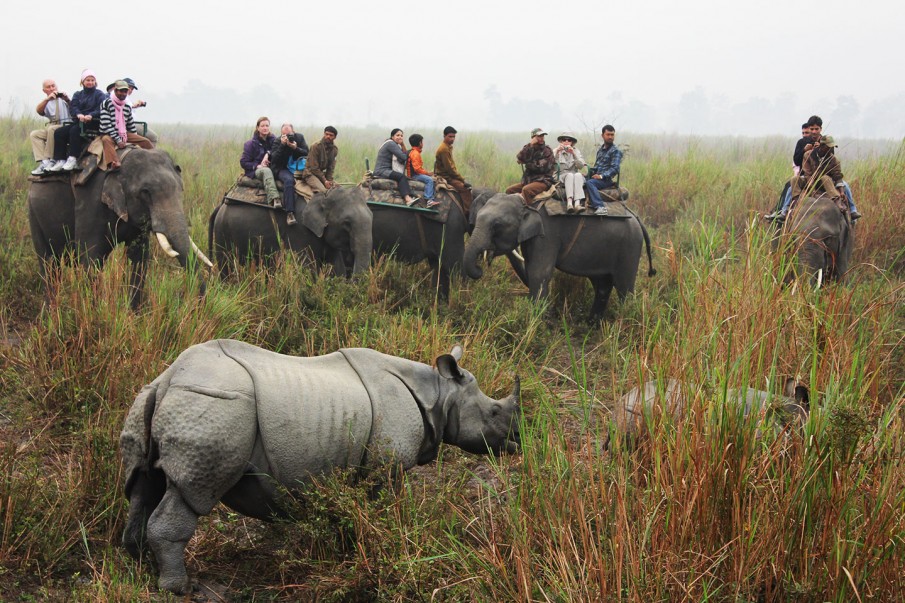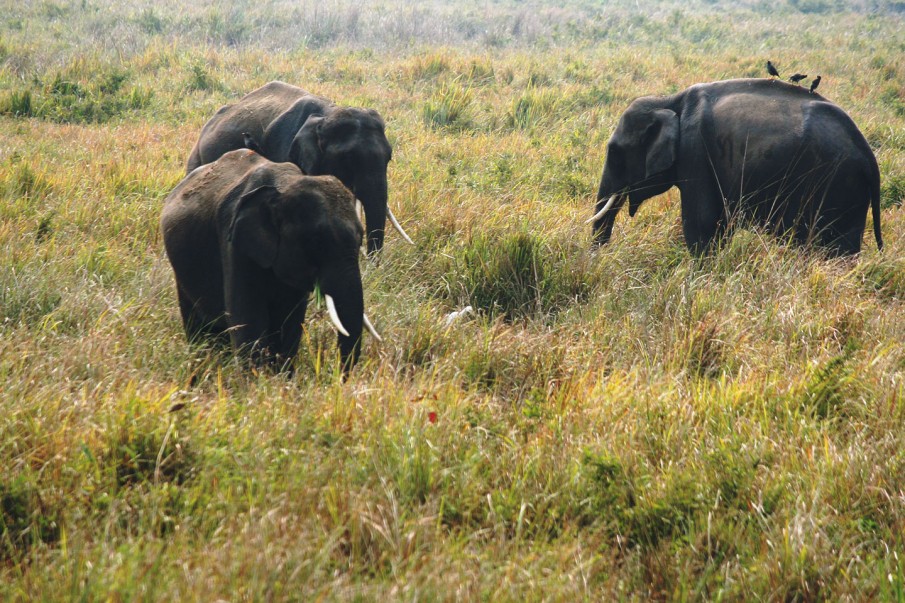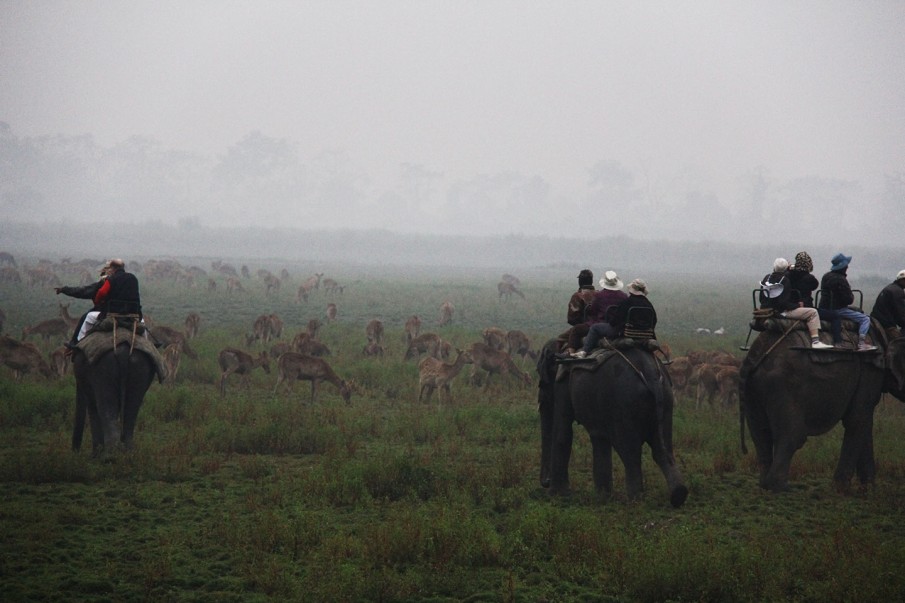14 Days / 13 Nights from $5621 pp – land only
This is an itinerary with a difference combining a visit to some of the iconic monuments of the Golden Triangle with a 7 night cruise on the Brahmaputra River in Assam. This unique combination – a cultural and historical experience combined with soft adventure, makes for an enchanting and a complete journey to “Experience the Living Cultures of india”..
Itinerary
Day 1 (Tuesday): Arrive Delhi
After clearing immigration and customs, our representative will meet you at the receiving area and escort you to your hotel.
Delhi is a dynamic city where the past coexists with the present. While historic evidence shows that the area around Delhi was first occupied around 2,500 years ago, Hindu mythology predates that by another 500 years. The British captured the city in 1803 and when they decided to make it the capital of India in 1911, they commissioned Sir Edwin Lutyens to draw up the plans. The result is slightly surprising with spacious tree-lined avenues punctuated with architecture which is among the most striking in the world.
Overnight at the hotel
Day 2 (Wednesday): Delhi
After breakfast, experience the combined charm of Old and New Delhi.
The day begins with the sightseeing of Old Delhi and a visit to the Raj Ghat. Drive past the Red Fort on your way to the Jama Masjid, India’s largest mosque. A tour through the bazaars of Chandni Chowk is followed by a drive past the historical India Gate, the President’s estate and the Parliament House. The day is concluded with a visit to the capital’s most striking monument; the 70 meter high Qutab Minar.
Overnight at the hotel (B)
Day 3 (Thursday): Delhi / Agra
(approx. 220km/5 hour drive)
After breakfast drive to Agra.
On arrival, check in to the hotel.
Visit the red sandstone Agra Fort, which stands like a crescent on the banks of the Jamuna River enclosed by forbidding 20-meter high walls, with a 12-meter moat between them. Three successive Mughal emperors – Akbar, Jehangir and Shah Jehan – helped create this massive structure which contains Hindu and Muslim architecture.
Later at sunset, visit the Taj Mahal surely the greatest monument to love and one of the wonders of the modern world. Completed in 1652, skilled craftsmen from Persia, Turkey, France and Italy and some 20,000 laborers worked for 17 years to build this edifice, constructed by Emperor Shah Jahan as a mausoleum for his beloved queen Mumtaz Mahal.
Return to the hotel.
Overnight at the hotel (B)
Day 4: (Friday): Agra/Jaipur via Fatehpur Sikri
(approx. 260km/5 hour drive)
After breakfast drive to Jaipur. En route visit Fatehpur Sikri, the sandstone city, was the glorious but short-lived imperial capital of Akbar, the greatest of Mughal emperors. Lying on a rocky ridge, it boasts of palaces, forts and mosques representing a variety of architectural styles.
On arrival check in to the hotel.
Enjoy Dinner with a Noble family. (Experiencing the Living Cultures of India) .
Overnight at the hotel (B, D)
Day 5: (Saturday): Jaipur
After breakfast, half-day excursion tour takes us to the Amber Fort. En route, we make a photo stop at the palace of winds the Hawa Mahal. A 5 stored building with 25cm thick facade from the 18 century having 953 windows and niches so that ladies of royal family could see the procession and events in the city without being visible to the people.
Proceed to the Amber City Fort situated 130m high with the Aravalli hills around and 11 km north of Jaipur. It was the ancient capital of the Kachhawaha Rajputs till 1037. Enjoy an Elephant ride to the top of the Palace fort.
In the afternoon visit the “Pink City” of Jaipur. The City Palace occupies the center of Jaipur. It now houses the Royal residence and museums with collections of textiles and costumes, armory, manuscripts, paintings etc.
Also visit Jantar Mantar (1728-34) built by King Jai Singh II who had great interest in astrology.
Overnight at the hotel (B)
Day 6: (Sunday): Jaipur / Jorhat / Nimati / M.V Mahabaahu
After early check-out from the hotel drive and transfer to Jaipur airport to connect with flight to Jorhat.
On arrival at the ‘Rowriah airport’, Jorhat, we are met at the receiving area by our destination manager. We then board our vehicles with packed lunch and drive to Neamati Ghat to board the M.V.Mahabaahu where we will be welcomed in the Assamese tradition.
We check into our cabins and immediately gather in the restaurant for the essential safety briefing and drill followed by a familiarisation tour of MV Mahabaahu. The tour takes us to the Donyi Polo Deck to experience the first sail and we raise a traditional toast to the mighty Brahmaputra River that carves the valley of Assam where we will be spending the next 7 nights and 7 days. We relax here sipping Assam tea/coffee, whatever the taste buds crave for and enjoy the snacks.
We proceed into the evening with a talk on ‘Sibsagar: Seat of Ahom Culture in Assam’. Soon MV Mahabaahu drops anchor and the evening follows into a ‘Kamrup Swaagat Bhoj’ or welcome dinner in the Mungri Mungram Restaurant with the Chef’s lavish spread of Asian, continental and oriental cuisine that demands a buffet display.
Overnight on board M.V.Mahabaahu (L, D)
Day 7: (Monday): Neamati Ghat/Sibsagar/Neamati Ghat
We start the day with Yoga on the Donyi Polo deck for the very early birds and enjoy an early breakfast as we sail towards Neamati Ghat. We then take a short boat ride to the shore from where we start our day-excursion to Sibsagar, the ancient city of the Ahom Kings; a town that literally means ‘the ocean of Lord Shiva’. The district is strewn with the tell-tale ruins of a powerful empire of the Ahoms. Sibsagar was the capital of the Tai-speaking Ahoms who came to the area from Yunan and China in the 13th Century AD.
We go on to visit the Talatal or Karen Ghar which was the palace of the Ahom Kings and after a leisurely stroll in and around the monument we go on to Rang Ghar which was a place for hosting wrestling bouts and buffalo fights and other entertainment for the royals and their guests.
We proceed to Sibsagar town that is built around a huge man-made water tank ordered by the queen and dug over 200 years ago. On its banks are located some of the famous temples of Sibsagar. The Shiva Dol, constructed in the year 1734 is believed to be the highest Shiva temple in India.
At noon, we drive on to a Tea Estate for a relaxed afternoon and a traditional Assamese lunch with the family to get a peep into the lifestyle of the families that have been involved in the tea business for generations. As we sip our beverages and explore the lawns, the cultural performances begin and we proceed to indulge in traditional Assamese cuisine.
After the taste buds are eased we are ready for a serious Talk by the professionals on ‘Different types of Tea’ especially the ones produced in Assam which is followed by a tea-tasting session. We then return to M.V.Mahabaahu that is moored to a quiet corner of Neamati Ghat.
We steal an hour of quiet in the comfort of our cabins and then proceed for a relaxed dinner thereafter. Dinner and interactions with all on board is a happy come together and we take this opportunity to know the crew this evening.
Overnight on board M.V.Mahabaahu (B, L, D)
Day 8: (Tuesday): Neamati Ghat/Majuli/Towards Bishwanath Ghat
We sail on towards Majuli Island while an early morning Yoga session or bird watching is on. Majuli which literally means land between water is a cosmos of Assamese culture where various philosophies co-exist and thrive; ancient monasteries dedicated to preservation and development of culture and art have existed here since the 15th Century.
The treasures of Majuli are undoubtedly its Monasteries or Satras that promulgate a form of Hinduism that is called Vaishnavism. These Satras are the hub of culture, art, religion and lifestyle. The Satras preserve antiques like weapons, utensils, jewellery and other articles of cultural importance.
After breakfast, we have a talk on ‘Majuli and Vaishnavism’ and get acquainted with one of the largest river island systems of the world. We then take a short boat ride to the mainland where a drive takes us to a scenic corner of ‘Garamur Satra’ for an interesting cultural performance by Satriya singers and dancers. The art of relating mythical tales through dramas and masks is an important part of Majuli culture.
After soaking in the untouched beauty of the area and a tête-à-têtewith the performers, we move to ‘Kamlabari Satra’ to witness another performance by the Vaishnavite priests in the temple premise. We walk through the humble dwellings of the monks and talk about their daily chores and this is an insight into their chosen path.
We drive back to the shore for our short boat ride back to M.V.Mahabaahu and set sail towards Bishwanath Ghat.
This evening we can enjoy a relaxed quiet walk on a deserted island or a game of cricket or volley ball etc. We take some time to get ourselves together for a comfortable evening under the stars with cocktails to order on the sandy island (expect sand between your toes and the breeze could be comfortable to chilly, a light jacket would be advisable) and of course a bonfire is on the charts.
NOTE: (Bonfire may be avoided if a suitable sandbank cannot be found or if we experience inclement weather conditions)
Overnight on board M.V.Mahabaahu (B, L, D)
Day 9: (Wednesday): Sailing towards Bishwanath Ghat
Yoga enthusiasts enjoy an early morning Yogic walk or a Yoga session as M.V.Mahabaahu sails on.
After breakfast, we proceed for a talk on ‘The River Brahmaputra and the tribal life that exists alongside’.
We arrive at a ‘Mishing’ village and disembark on smaller boats to reach the village banks. The ‘Mishing’ are an ethnic group inhabiting a number of districts in Assam. It is popularly believed that they were dwellers of the hills of present day Arunachal Pradesh and migrated to the plains of Assam in search of fertile land as well as in search of civilizational progress. Almost all ‘Mishing’ women are expert weavers on handlooms. We get a ‘Mishing’ man to give us a dhoti tying demonstration and a woman to show the ‘Mekhela Chaddor’ tying demonstration. (Dhoti & Chaddor are the traditional dresses of the Mishing).
After climbing up the house platform and exploring Mishing homes, purchasing some of their weaves/fresh vegetables etc. we return to the comfort of M.V.Mahabaahu for a fine leisurely lunch. (You can carry cash to the village to buy the handicrafts made by the villagers to encourage local craft).
After lunch, we are ready for a boat safari on the Eastern range of Kaziranga where the two waters of River Dhansiri and River Brahmaputra meet. Here, the presence of hovering pied kingfishers is an indication of fish life & the fallen branches of trees into the river support roof turtles. Monitor lizards as well as otters are very much a part of this area. Asiatic water buffaloes are known to swim over from the park to the sand banks on the other side of Dhansiri. Endangered vultures and eagles too can be spotted. Several migratory birds depending on the time of the year feature themselves in this area. We must keep our fingers crossed and hope for the best.
We gather our experience of the evening and return to M.V.Mahabaahu where the Chef awaits our return to involve us in his cooking demonstration. Our chef talks of the ingredients while we pour ourselves a cup of tea. We enjoy these freshly prepared dishes and snack on them. After some leisure we try our hand at the Assamese dresses that we had watched the demonstration for, this afternoon. We enjoy a cat walk in the Mungri Mungram and indulge in a lavish dinner by the Chef.
Overnight on board M.V.Mahabaahu (B, L, D)
Day 10: (Thursday): Bishwanath Ghat/Silghat
As we indulge in some Yoga, M.V Mahabaahu sails towards Bishwanath Ghat. After a leisurely breakfast followed by a talk on ‘Kaziranga and wild life in India’ and a short orientation on Bishwanath Ghat (also called ‘Gupta Kashi’), we take the smaller boats to visit this charming village. We visit the Shiva Dol in reverence of Lord Shiva and there is no way that we can avoid the women with their weaves and enjoy an excellent bargaining hour for the home-spun weaves as we watch the ladies busy at their handlooms. (You can carry cash to the village to buy the handicrafts made by the villagers to encourage local craft). We walk through the streets near this Ghat and move towards a quaint little pretty rocky inlet of the Brahmaputra.
We return to M.V.Mahabaahu and sail on for the next couple of hours as we enjoy a relaxed lunch. We reach Silghat and M.V.Mahabaahu drops anchor.
We take a short drive to a tea estate where we can stretch our legs and enjoy a leisurely walk through the tea estate watching the tribal women picking tea leaves. Here we stop for a talk with the Manager of the tea estate who familiarises us with the essentials of running a tea-estate, the lay of the land and the climate. We proceed to the tea factory to see the process of finally producing Assam Tea and coming to terms with ‘all that goes into preparing a cup-of-tea.
By sunset we are ready to drive back to MV Mahabaahu to enjoy a cultural evening on board followed by dinner and retire early for the next morning elephant safari.
Overnight on board M.V.Mahabaahu (B, L, D)
Day 11: (Friday): Silghat/Kaziranga National Park/Towards Guwahati
Rise before the sun and after a warm cup of tea and some biscuits to snack on, set off for the Kaziranga National Park’s Kohora Gate and a once-in-a-lifetime elephant-backed safari where we search for the elusive rhinoceros. Designated as a World Heritage Site by UNESCO, Kaziranga National Park is located in the flood plains on both sides of the Brahmaputra. The most prized inhabitant of Kaziranga is the Greater One-Horned Indian Rhinoceros, but the Park is home to as many as 180 different mammals including wild elephants, tiger, deer, bison, and a rich variety of birds. Kaziranga means the “Land of red goats (Deer)”, as the word Kazi in the Karbi language means “goat”, and Rangai means “red”.
After breakfast at a resort in Kaziranga, we drive on to Bagori, the Western Range of Kaziranga and get into the open jeeps that are lined up to take us for some more wild life adventure and an extensive coverage of this magnificent park dotted with large water bodies called ‘beels’ in the local language.
We return on board for a fine leisurely lunch as the M.V.Mahabaahu sails towards the famous town of Tezpur and passes under a famous 3 Km 15 m long arched bridge called Kolia Bhomora Setu.
We have a relaxed afternoon to snatch a couple of hours of sleep we lost in the wee hours of this morning.
We spend the evening in the Soma Lounge and then to Mungri Mungram for dinner. We can then choose to watch a documentary or retire for the evening.
Overnight on board M.V.Mahabaahu (B, L, D)
Day 12: (Saturday): Sailing towards Guwahati
We start this morning with Yoga for those who love to pay homage to the forces of nature, the ultimate ‘Sun God’ perhaps on an island or on the deck for an hour. Others scan the river for a fleeting sight of the Gangetic Dolphins and the birders inspect the skies for the winged species.
We move on to breakfast while M.V.Mahabaahu heads on for a full day sail passing by inhabited and deserted islands that may or may not survive the flood season. It is the non-permanency of these islands and the strength of the people to re-establish themselves is what catches ones attention.
This is a day for sunbathing on the Donyi Polo Deck or a dip in the pool or indulging in massages or sitting in the warm waters of the Jacuzzi or enjoying a steam/sauna and getting rid of one’s tiredness from the journey. We indulge in a relaxed lunch and then after tea we proceed for a talk on ‘Kamakhya and the occult in Assam’
After a leisurely hour, we move to Mungri Mungram for ‘Alvida Bhoj’ or Farewell Dinner where a traditional toast is once again raised but to Devi Kamakhya for the journey safely completed and the one ahead.
Overnight on board M.V.Mahabaahu (B, L, D)
Day 13: (Sunday): Guwahati to Delhi
Yoga for those of us who may create time, or maybe an early morning indulgence in the spa or a hair do and settling of all extras before breakfast as we pass by the smallest river island called the Peacock Island where the Umananda temple is located. Peacock Island is famous for the highly endangered Golden Langur. It would be a good idea to have one’s binoculars and cameras at hand. We then proceed to place our suitcases in the corridor before breakfast and enjoy a relaxed breakfast. With packed lunch, we bid adieu and move towards Kamakhya Temple. This Temple is devoted to the eternal feminine, the goddess of desire whose name is Kama Khya, granter of desires. The Kamakhya Temple in Assam symbolizes the “fusion of faiths and practices” of Aryan and non-Aryan elements in Assam.
Walking up to the temple complex, we will see many colorful idols of gods and goddesses in the local market shops.
We then drive to the Guwahati Airport to board our flight to Delhi
Overnight at hotel (B, L)
Day 14: (Monday): Depart Delhi for onward journey
Depart Delhi for onward journey
Inclusions:
- 5 nights touring the Golden Triangle in your own a/c private vehicle with driver
- 5 star accommodation on twin share basis in Delhi, Agra & Jaipur
- 7 night Brahmaputra cruise aboard the MV Mahabaahu in a superior cabin
- All excursions/lectures/performances and activities as per the cruise itinerary
- All entrace fees at the monuments as per itinerary
- Dinner wuth local family in Jaipur
- Services of local English speaking guides
- Domestic airfares Jaipur to Kolkata – Kolkata to Jorhat – Guwahati to Kolkata
- Assistance and porters at the airports
Exclusions:
- Airfares (contact us for the best available airfares to India for time you wish to travel)
- Expense of personal nature like laundry, telephone
- Travel Insurance
- Any tipping
- Any meals or beverages that are not specified in the above inclusions
- Any other services not mentioned in the inclusions
- Any further tax levied by the government of India





